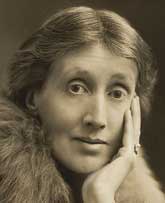Virginia Woolf
Critique • Works

VIRGINIA WOOLF, 1929 (by unknown photographer)
Born
London, England, 1882
Died
Lewes, East Sussex, 1841
Publications
Novels, stories, essays, biographies, memoirs, diaries, letters
Writing languages
English
Writing places
Bloomsbury, London, England; Sussex
Literature
• Mrs Dalloway (1925)
• To the Lighthouse (1927)
• The Waves (1931)
Novels
• Mrs Dalloway (1925)
• To the Lighthouse (1927)
• Orlando (1928)
• The Waves (1931)
• The Years (1938)
Stories
• "The Mark on the Wall" (1917)
• "Kew Gardens" (1919)
British Literature
• Mrs Dalloway (1925)
• To the Lighthouse (1927)
• Orlando (1928)
• The Waves (1931)
The poet of the novel
"Who's afraid of Virginia Woolf?" asked a famous play in the 1960s. The answer might be: undergraduate students, for having to work through her dense, poetic, stream-of-consciousness novels in English courses.
Or the answer could be: The general reading public who know her stuff is supposed to be good for them but struggle with it because, like, nothing happens in her stories.
Or her intellectual friends who often found themselves portrayed, thinly disguised, in her writing. (Novelist D.H. Lawrence, playwright George Bernard Shaw and philosopher G.E. Moore are supposedly among those exposed.)
Or chauvinistic men, for she has been taken up as somewhat of a feminist icon.
Or perhaps even herself, for Woolf in her works often expressed a discomfort with her own corporeal being. Unlike that other great totem of stream-of-consciousness experimentation, James Joyce, whose mental gyrations celebrated physicality, Woolf's writing could express horror over existence at anything less than a pure intellectual level.
But, her ability to strike fear aside, Virginia Woolf is one of the acknowledged giants of twentieth-century English literature.
Nervous breakdowns
Adeline Virginia Stephen was born into an aristocratic literary family in London, England. In her twenties she founded with her brother an intellectual circle known as the Bloomsbury Group, which included some of the leading writers, philosophers, artists and politicians of the day. She and husband Leonard Woolf, whom she married in 1912, started Hogarth Press which printed works by Katherine Mansfield, T.S. Eliot and eventually Virginia Woolf's own writing.
Despite suffering repeated mental issues, she produced seven major novels herself. She began with The Voyage Out (1915) and Jacob's Room (1922).
But it was Mrs Dalloway (1925), detailing a single day in an impressionistic stream-of-consciousness style, that first earned her plaudits as a writer in her own right.
To the Lighthouse (1927) was a further development of this approach and won her public fame. Orlando (1928) in contrast was a fantasy spread over four centuries.
The Waves (1931) is an extremely poetic depiction of six friends through the years that some consider her greatest achievement. Her last novels were The Years (1938) and Between the Acts (1941).
After suffering several breakdowns throughout her life, Woolf committed suicide in 1941. Her literary criticism was later collected in two editions of The Common Reader during her lifetime and her nonfiction compiled in the posthumous volumes Collected Essays of Virginia Woolf (1967). Her five-volume Diary and six-volume Letters, published in the 1970s and 1980s, have further enhanced her reputation.
A collection of her autobiographical writings, Moments of Being (1976), despite its precious title, is a highly readable account of her strange life, and gives often surprising insight into the intellectual, familial, social and sexual forces that shaped her fiction. It also makes one wonder whether Woolf might have become a greater poet or essayist.
In recent decades, the long essay "A Room of One's Own", first published in 1929, has perhaps become her most cited work, dealing as it does with the struggle of women as writers and artists.
A more recent novel, The Hours by Michael Cunningham, and the excellent film of the same name are based on Woolf and two later fictional characters and provide an idea of Woolf's strange personality. The movie however might give the mistaken impression that she was working on Mrs Dalloway before she died, when in fact that novel was published sixteen years earlier.
— Eric
Critique • Works

